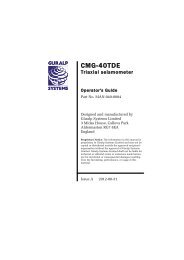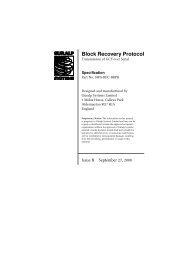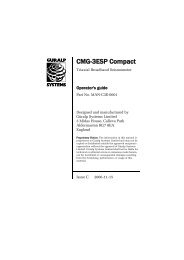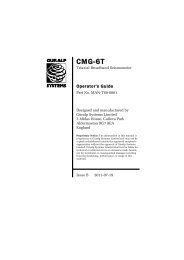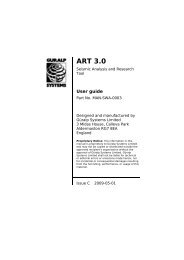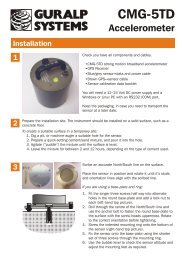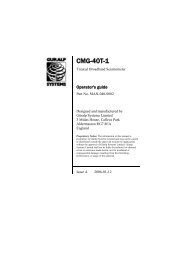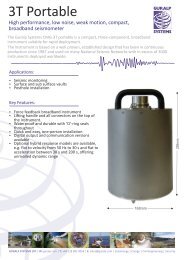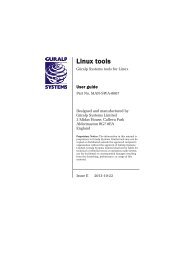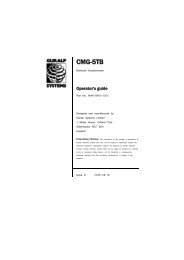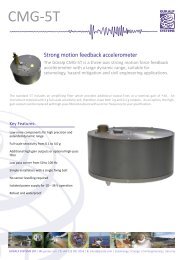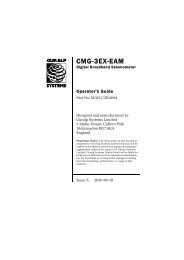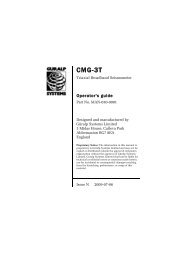MAN-C24-0001 - Güralp Systems Limited
MAN-C24-0001 - Güralp Systems Limited
MAN-C24-0001 - Güralp Systems Limited
You also want an ePaper? Increase the reach of your titles
YUMPU automatically turns print PDFs into web optimized ePapers that Google loves.
CMG-CD24<br />
The CD24 initially samples incoming data at 2000 Hz. These data are<br />
then filtered and reduced to a lower rate (decimated) using an onboard<br />
digital signal processing unit, or DSP. The DSP has several<br />
filtering-decimation stages, which run one after the other. Stages<br />
which can produce output (and the outputs from those stages) are<br />
called taps. The CD24 can output 4 taps simultaneously.<br />
Each configurable tap can be set to a different decimation factor by<br />
choosing values from the drop-down menus on the left. Decimation<br />
factors of 2, 4, 5, 8, and 10 are available. The numbers visible in the<br />
drop-down menu of each tap are the data rates that each of the<br />
possible decimation factors will provide, given the settings of the taps<br />
above it. Only integer (Hz) data rates are allowed: thus, for example, if<br />
one tap emits data at 25 Hz, the only possible further decimation factor<br />
is 5.<br />
To the right of each decimation factor menu is a grid of check-boxes.<br />
These boxes mark which streams of data to generate at each sample<br />
rate. The screen shot above shows a possible configuration for a<br />
triaxial instrument. Every channel of the digitiser may be output at<br />
any tap; currently, as illustrated, all three axes are being output at Tap<br />
2 (20Hz).<br />
If you want to change the names used for the channels, click in the<br />
white box containing a Z in the above picture and type a letter or<br />
number. It will name the channels with a sequence of letters or<br />
numbers beginning with the one you choose (e.g. A, B, C; 2, 3, 4; 9, A,<br />
B), unless you type Z in which case they will revert to Z, N, and E.<br />
Each combination of channel and tap has two check-boxes. The upper<br />
check-box of each pair activates continuous output, whilst the lower<br />
activates triggered output. In the example above, the digitiser will<br />
output data continuously for all three channels at Tap 2, but never for<br />
any other taps. If you do not need all the streams to output at all rates,<br />
you should leave boxes unchecked to save communications capacity.<br />
You cannot check both continuous and triggered output for the same<br />
channel and tap.<br />
When you enable a triggered stream, the digitiser will output data in<br />
that stream only when a particular set of trigger criteria are met. This<br />
is shown diagrammatically as data passing through a switch. In the<br />
example above, we might want the high-rate data from Tap 0 to be<br />
generated only when an event registers at some other tap. To do this,<br />
tick one or more of the lower set of check-boxes for Tap 0.<br />
With this configuration uploaded, Tap 2 will continue to produce<br />
output at all times, but Tap 0 will also emit data whenever the trigger<br />
28 Issue C




